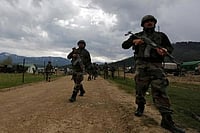Amid the rising speculation on the infections linked to the radio collars to be the cause of the consecutive deaths of the Cheetahs at the Kuno National Park of Madhya Pradesh, the head of the Project Cheetah SP Yadav, who is also a member secretary of the National Tiger Conservation Authority (NTCA), has dismissed the claims citing that carnivores and animals across the world are monitored by radio collars and this is a proven technology.
Centre's ambitious 'Project Cheetah' will complete one year this month. Last year on September 17, PM Modi released Namibian felines into the wild at Kuno marking a historic moment in India's wildlife conservation efforts.
Nine cheetahs died in Kuno National Park since March this year.
What did the Project Cheetah chief say?
When questioned about the infections caused by the radio collar, Yadav said, “There is no truth that any cheetah died due to radio collars. I want to say that monitoring is not possible in the wild without radio collars.”
“A total of 20 cheetahs were brought from Namibia and South Africa out of which 14 (adults) are completely healthy and are doing well. Four cheetahs were born on the soil of Bharat and one of them is now six months old and is doing fine. The three cubs died because of climatic factors," Yadav told reporters.
The chief also said that no cheetah died at the Kuno National Park due to “hunting or poaching”.
"Generally, in other countries, poaching and hunting leads to deaths but our preparation was so good that not even a single cheetah has died due to hunting, poaching, or poisoning.. nor has any cheetah died due to human conflict..we have successfully achieved milestones in the past year,” he said.
"There has never been an attempt to move a cheetah from one continent to another and this was the first wild-to-wild translocation and there were a lot of challenges in it. Usually, in such long-distance translocation, a cheetah may die because it is a sensitive animal but no such death occurred here and the translocation was very seamless," he added.
Explaining India's plan to relocate the next batch of Cheetahs, Yadav said, "Preparations are going on for next batch of cheetahs at two sites, one is Gandhi Sagar Wildlife Sanctuary in Madhya Pradesh, where the habitat is suitable, and the work of making enclosure is going on at a very fast pace.. I hope that in November-December the work of fencing and enclosure will be complete and a decision will be taken to bring cheetahs there after inspection."
Following the translocation of 12 cheetahs in February from South Africa, the plan is to translocate 12 annually for the next eight to 10 years.
Monitoring of the Cheetahs
At Madhya Pradesh's Kuno National Part, each of the cheetahs has been equipped with radio collars for constant monitoring of their movements in real time through satellite technology.
The surveillance mechanism is maintained through an extensive network of CCTV cameras strategically positioned throughout Kuno National Park.
Moreover, to ensure precision, "machaans" (elevated observation platforms) have also been set up in the forest area to provide additional vantage points for monitoring the cheetahs' activities.
A dedicated Cheetah Monitoring and Control Room has been established within the national park to centralize the tracking and observation efforts.


























